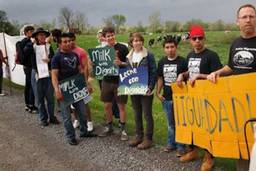With Solidarity in Spades, Vermont Bus Drivers’ 18-Day Strike Results in Big Win
Jonathan Leavitt
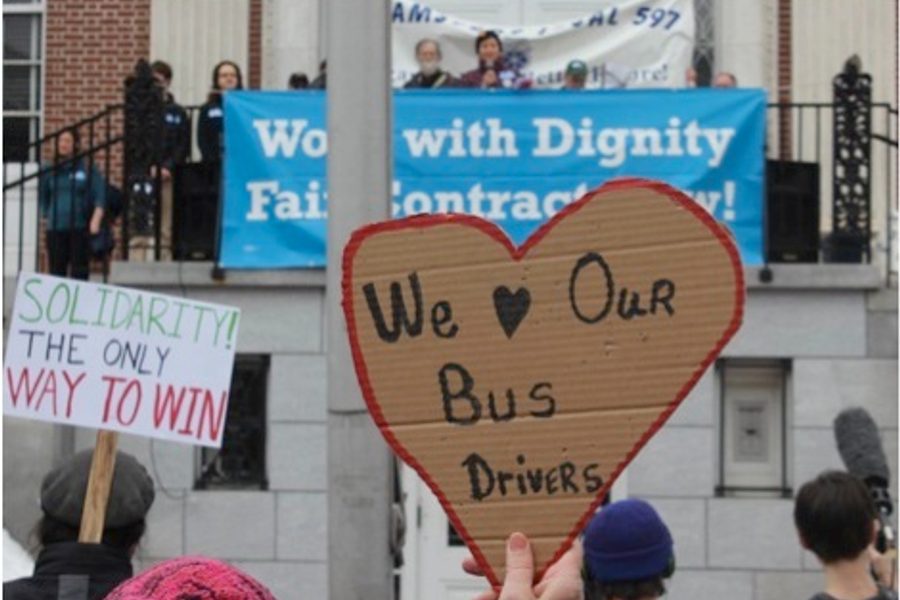
At 6am on March 17, St. Patrick’s Day, 40 bus drivers and a dozen community members defied negative-10-degree weather to picket outside the Chittenden County Transportation Authority (CCTA) bus garage in Burlington, Vt. The action marked the beginning of nearly three-week-long transit strike over concessionary contract demands that would capture the imagination of much of Vermont and culminate in victory.
“Management misjudged us,” said CCTA driver Jim Fouts, speaking to In These Times from the impromptu victory rally on April 3. “We don’t drive together, we don’t have a lunch room to eat together,” said Fouts. But on the picket line, he says, “we turned into icicles together and we started to get to know one another.”
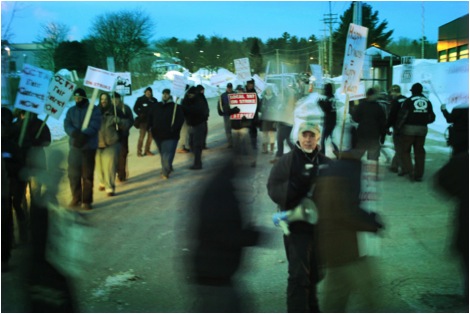
Traven Leyshon of the Vermont AFL-CIO leading Teamsters 597 members and supporters in chants on a negative 10 degree picket line. (Full disclosure: The author was part of the strike’s solidarity committee and is a member of the Vermont Workers’ Center, which supported the strike.)
After months of failed negotiations and working without a contract since June 30 of last year, drivers voted 54-0 on March 12th to reject CCTA management’s final contract offer. Drivers could not stomach monitoring disciplinary procedures that they saw as “abusive,” such as being tailed by supervisors, reviewed via bus videotapes, and suspensions of as long as a month. The added demand that drivers work eight hours over the course of an exhausting 13.5-hour “split shift,” which could be extended through forced overtime to 15 hours, sparked concerns among bus drivers and community members that CCTA management’s demands risked “community safety.”
A new generation of strikers
St. Patrick’s Day fell on a Monday, a school day, and the temperature was negative 5 degrees, but at 7a.m., a steady stream of parents dropped off their students to march the picket line. Seventy-one Burlington High School (BHS) students walked the proverbial mile in another’s shoes, shoulder to shoulder with their bus drivers in a show of solidarity that harkens back to a much older, bolder labor movement. The students accompanied the bus drivers every foot of the circuitous 2.3-mile bus route from the Cherry Street picket line to the front office of the high school, where administrators greeted the students with applause and excused absences. The handmade signs students carried would paper the lobby for the duration of the strike.
“This is Vermont, and even record cold temperatures cannot keep us away from supporting the workers of our state,” says Sabine Rogers, a senior at BHS. “Students showed how much they support fair working conditions and how much they support the work that you bus drivers do each and every day.”
“As we started to walk, we went from a fairly quiet group to chanting with a bullhorn and really getting into it,” says BHS senior Henry Prine. “One quiet student told me he doesn’t like loud noises or large crowd, but it was such an incredible experience. He fell in love with organizing in that moment.”

BHS Students on the picket line beside their CCTA drivers.
Prine detailed the prefigurative movement-building BHS students did before the strike. Through his student delegate position on the school board, Prine convinced the body to pass a resolution stating the school district would not hire scab bus drivers to cross picket lines. Prine says that as negotiations broke down and a strike appeared imminent, he began talking with other seniors (“and underclassmen too”) about ways BHS students could take an even more powerful public stand. The students drafted a petition calling on CCTA management to meet the drivers’ demands, and Mayor Weinberger and the Burlington City Council to support the bus drivers.” According to Prine, the petition drew more than 500 signatures in one day’s time. “That’s more signatures than people get to keep the hockey program,” he says.
This petition would be presented to Democratic Mayor Miro Weinberger in a March 10 City Council meeting by ten BHS student organizers. Weinberger and his City Council allies had earned a reputation as anti-labor for gutting Burlington’s Livable Wage Ordinance despite popular support for policies to reduce the growing disparity of wealth.
Rogers, motivated by her experience on the strike line, would build out a student carpool in solidarity with drivers, using some dusty ward maps to collectivize students’ overlapping routes to school. In the strike’s final week, students organized teachers to host bus drivers in their classes. Striking drivers presented labor history and origin story of their job action to 80 students in four classes in the three days leading up to the strike settlement.
Rogers believes the experience transformed a culture of alienation at her school. “The solidarity and community and sense of activism that has been such a big player in this whole past few weeks — I definitely see that continuing as part of the atmosphere at BHS,” she says.
‘This is the movement of the people’
Nine days into the strike, the drivers would face a massively heavy lift. With the backing of Mayor Weinberger, eight of the 14 members of Burlington’s City Council co-sponsored a resolution calling for the contract negotiations to enter “binding arbitration.”
According to a statement in responde to the resolution by the Vermont Federation of Nurses and Healthcare Professionals (a local of AFT Vermont), binding arbitration decreases the likelihood of a favorable outcome for workers and communities by placing “all decision-making in the hands of a third party, someone with no relationship to the workplace or community directly affected by his or her decision” and who is not accountable for the results.
To speak against binding arbitration, 150 drivers and supporters marched upon the City Council’s March 26 meeting, chanting “We are the union, the mighty, mighty union!” After they filed into the chamber, City Council President Joan Shannon informed the crowd that the customary public comment period at the beginning of the meeting would be delayed by a special executive session. At that point, the entire driver solidarity march assembled outside the chamber door and unleashed perhaps the most boisterous rally City Hall has ever seen.
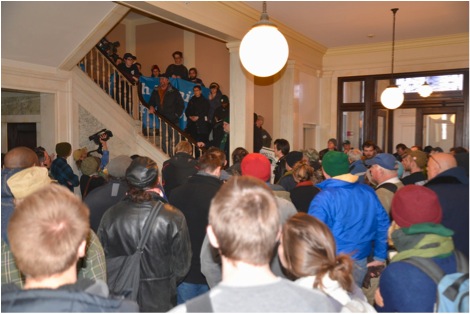
Bus drivers, other unions and community solidarity activists lead a speak-out in Burlington City Hall on March 26.
The hallway and steps leading to City Hall’s second floor and the Mayor’s office were suffused with swelling throng of students, members of United Electric (UE), the Vermont Workers’ Center, the Vermont State Employees Association, Vermont National Education Assocaition (Vermont NEA), the newly formed Vermont Homecare United (a local of ASFCME) and many bus drivers. Loud applause and chants of “What do we want? Fair Contract! When do we want it? Now!” resounded in hallway’s marble and into the City Council chamber in a scene many would compare to the 2011 occupation of the Wisconsin Capitol by pro-union protesters.
“Where is the freedom? Where is the chance?” bus driver Noor Ibrahim, an immigrant from Somalia, asked the impromptu rally. “I was told there is a chance here in this country. Where is the right of the poor people? [CCTA management] are misusing the money of the taxpayers. From now on we have this strike as experience, we don’t need to back down.”
Noor detailed how three years ago his wife was pregnant and “the doctor said the baby wasn’t moving.” He set up an appointment on his day off so he could support his wife, even filling out the vacation paperwork as an extra precaution. Less than 24 hours before the appointment, he said, CCTA’s management told him he would have to work. “When I asked them, they said ‘We don’t care about you, we don’t care about your family all we care about is the bus moving,’ ” said Noor.
As drivers continued telling personal stories like these and the raucous rally spilled over into public comment, two of the eight resolution sponsors, Karen Paul and Tom Ayers, pulled their names off. Councilor Paul was evidently moved by the driver’s stories; she introduced a successful amendment to “remove the resolution from the agenda” entirely, adding, “I’ve learned a great deal tonight. If we go forward with the agenda, I’ll remove my name from the resolution.” By the council meeting’s denouement, the focus had shifted from binding arbitration to a discussion led by progressive councilors of whether or not to sanction CCTA management.
“This is the movement of the people,” Nigerian CCTA driver Ade Fajobi told In These Times. “The voice of everybody changed the votes of City Council.”
‘Every step you take on your picket line is our step’
On Saturday, March 29, the 12th day of the strike, an all-night, 18-hour negotiation session broke down, yet again, over CCTA management’s demand to increase drivers’ split-shifts 12.5 to 13.5 hours. “They basically tossed the same pile of dung back in our faces,” said Jim Fouts. In response, hundreds of supporters gathered at Burlington City Hall, beneath a 12-foot wide bright blue banner reading “Work With Dignity” and “Fair Contract Now.” A massive University of Vermont (UVM) feeder march and brass band joined, and Vermont residents lent their voices to the drivers’ cause.

A brass band joins the picket line on the second day of the strike.
“By using your right to strike, you’re creating a stronger movement of workers,” said Amy Lester, a member of Vermont NEA and the vice-president of the Vermont Workers’ Center. “Your strength is our strength. Your courage is our courage. Your momentum is our momentum. Every step you take on your picket line is our step. We all have your back, keep fighting and don’t give up.”
To loud applause, FaRied Munarsyah, a Workers’ Center member and 20-year CCTA rider, called for “temporary replacement managers.” Michelle Gałecki of UVM’s Student Climate Culture said, “Livable jobs and public transportation is a green issue, but it’s also a human rights issue.”
“We have been swallowing this pain for the last ten years,” said Noor Ibrahim, from the steps of City Hall, with dozens of CCTA bus drivers behind him. “We cannot live in this hostile environment. We deserve respect.”
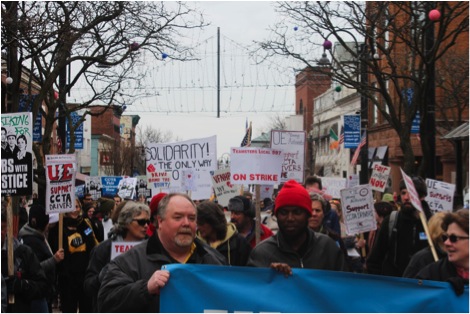
Chief Steward Mike Walker, driver Noor Ibrahim, and many more drivers leading the March 29 march.
Just days later, after threatening picket line-crossing scab drivers, CCTA management would finally capitulate. CCTA agreed to a contract with language limiting monitoring and discipline, reducing “forced overtime” to 13.5 hours a day instead of 15, and maintaining drivers’ split shifts at the current 12.5 hours. Though drivers conceded an increase from 13 to 15 part-time drivers, the union was able to win language preventing CCTA from using retirement or termination to reduce the entire bargaining unit slowly to part-time status. On April 3, inside the local VFW’s Eddie Laplant ballroom, drivers voted 53-6 to adopt the new contract.
A growing movement for work with dignity
According to James Haslam, director of the Vermont Workers Center, “In the current context of the attack on public transit, the public sector and the labor movement nationally, this is a tremendous victory for work with dignity that benefits all working people in the long haul.”
Indeed, the solidarity unionism that blossomed in Vermont’s late-winter snow could be — like the Chicago Teachers Union, Portland Teachers Union or Boeing Machinists—another harbinger of rebirth for rank-and-file reform movements buttressed by community solidarity.
The successful 18-day job action “really shows what happens when a few people speak out and continue to speak out towards a common goal of having a strong union,” said driver Jim Fouts in the bus terminal, in the afterglow of the victory celebration. “When I first came here the union was weak, because it was a business-as-usual union. Then some activists started saying, ‘This is wrong. We can vote on things. This is supposed to be a democracy.’ And really it was a bottom up movement to change our union.”
According to former drivers Chuck Norris-Brown and Scott Ranney, a reform caucus with the local solidified over breakfasts in local restaurants in the spring of 2009, around a petition circulated amongst drivers that helped win stewards elected by drivers, not merely appointed by Teamsters higher-ups. The caucus, nicknamed the Sunday Breakfast Club, soon began coordinating with Teamsters for a Democratic Union (TDU), a national, independent rank-and-file movement within the Teamsters. In 2011 contract negotiations, Breakfast Club members did the shopfloor organizing and the local outreach to community members and other unions to build public support. “A seed was sown which kept the Teamster Local to the grindstone, and almost all of the community action that resulted in major support for the recent drivers strike was based on earlier Sunday Breakfast Club contacts and strategies,” says Ranney, who also believes the caucus empowered rank-and-file members and paved the way for the unanimous rejection of the concessionary contract.
Tearing up, Fouts describes how Local 597 followed the advice of a Labor Notes organizer Ellen David Freidman, to build power and beat back concessions: “ ‘Turn enemies into neutrals, you turn neutrals into activists and you turn activists into leaders,’ ” he quotes. “That’s what we did.”
“We won this fair contract because of our unity and the tremendous support from our community,” says Rob Slingerland, CCTA bus driver and spokesperson for the drivers.
Many drivers, even in the midst of the victory party, said they’d already begun reciprocating the solidarity unionism they experienced from other unions during their strikes. “We were talking about solidarity with other unions before we even went over our contract today,” says Slingerland. He says that drivers have already volunteered to join marches on the boss at Vermont’s HowardCenter, a counseling and medical-services center where workers are in the process of unionizing with AFSCME. “We got the help and now we’ve got to give the help,” he says. “Vermont is so small, but this movement is so big.”
Slingerland described an “umbrella of fear,” his co-workers used to work under and how the victorious strike changed workplace power relations and gave drivers a sense of dignity. “A lot of drivers have discovered the power that they have within as a person,” said Slingerland, “you put that together as a group and you end where we are today, with a victory.”
AFSCME is a sponsor of In These Times. Sponsors have no role in editorial content.
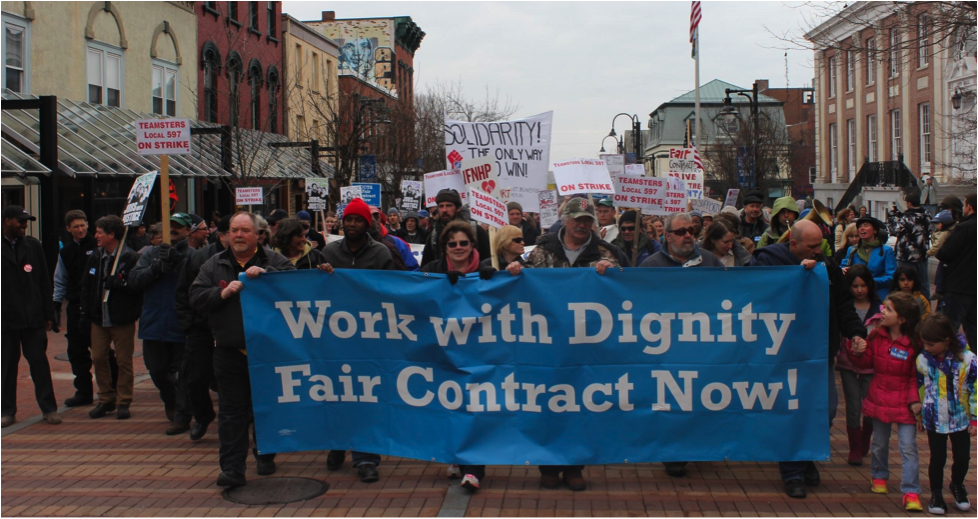
Striking bus drivers lead the March 29th community solidarity march with hundreds of supporters. .
